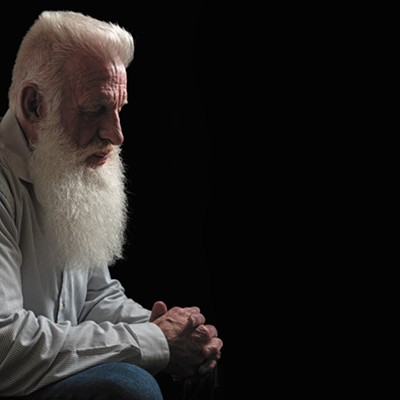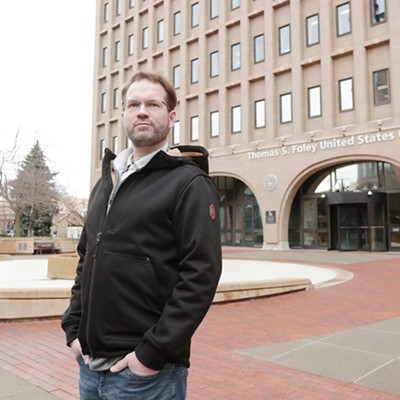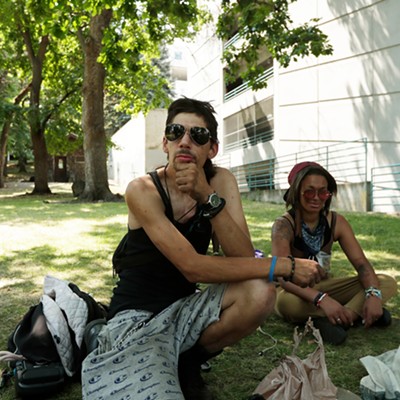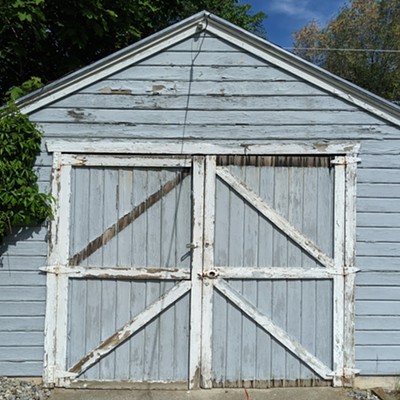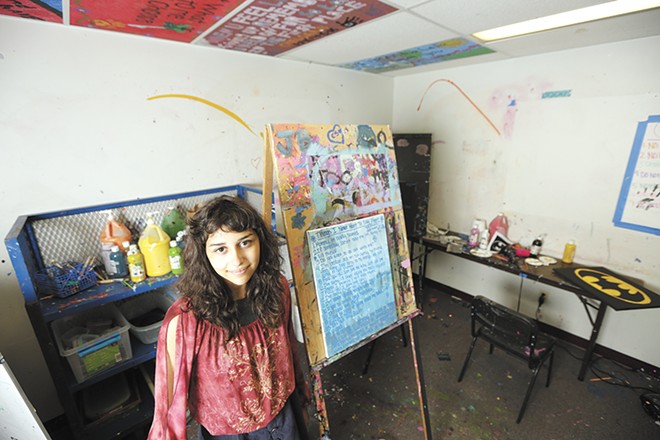
Angelina left home in May of this year, two months before her 17th birthday. Her dad told her she couldn't live in the house if she brought drugs inside. She wandered the streets of Seattle and ended up in The Jungle, the infamous and often violent homeless encampment underneath the freeways on the city's south side.
There, she says, she was sold to a guy who bought her with drugs and then held her captive.
Angelina, whose last name is being withheld because she's a minor, is calm as she tells her story to the Inlander. Wearing a black hoodie and gray sweatpants, she reclines in her seat at Daybreak Youth Services in Spokane, her fifth stint in rehab in the past two years. Soon, she'll be released and she'll live back with her dad. She doesn't want to relapse. She never wants to end up on the streets again.
"It's not a moral choice, like, 'Oh, I'm gonna go f--- my life up and do drugs," she says. "It starts from a young age, the addictive personality and being dependent on things, not just drugs."
In Washington state, 13,000 youths between the ages of 12 and 24 who are living on their own experience homelessness each year, according to a 2016 report compiled by A Way Home Washington, a coalition addressing youth homelessness in the state. That figure more than doubles under the broader school district definition of homelessness, which includes students who are temporarily couch surfing or staying with friends or family.
The state has recently come to recognize the scope of the problem and last year created the Office of Homeless Youth Prevention & Protection, tasked with identifying gaps that lead to youth homelessness and presenting a plan of action to state leaders.
"Our vision is that every family and youth in the state has the individualized support they need so that no young person has to spend a single night without a safe and stable home," says Kim Justice, Office of Homeless Youth executive director.
To pull that off, it will mean sealing cracks in the public system that releases some kids straight to the streets. It will require more housing and more shelters. It will demand more coordinated leadership in addressing abuse, drug addiction and family dysfunction before it gets to the point where children feel the streets are their best option.
Because, as was the case with Angelina, once she was on the streets, she couldn't get out.
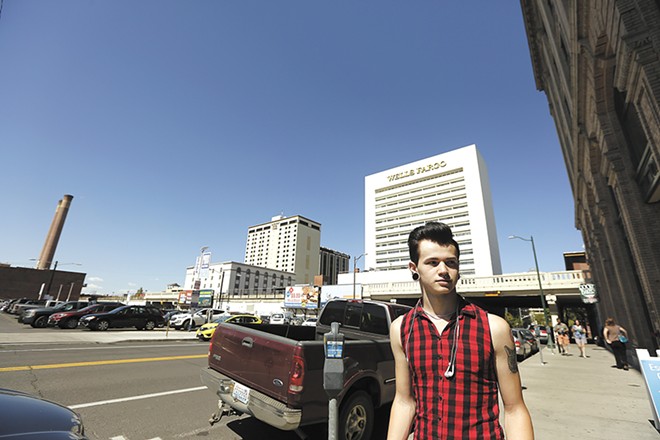
PLOTTING AN ESCAPE
Growing up in Seattle, Angelina was familiar with drugs and homelessness. She remembers sleeping in cars with her family, and living in apartments with mold growing on the walls. She watched her parents smoke crack in front of her.
"I was kind of fascinated. Like, what made them care more about drugs than me and my brothers?" she says.
First came Xanax. She snagged some from her dad's medicine cabinet when she was 13. At 14 she started taking more pills, drinking and smoking weed. Then it was acid. Then cocaine. She had been kicked out of several schools in the Seattle area for using or selling drugs. She went to rehab, where she spent her 16th birthday, followed by two weeks in a group home in Skagit County. Then came heroin and meth, and more trips to rehab.
Her dad, Ben Freitag, who has a different last name than Angelina, was himself in recovery, though he denies ever using drugs in front of his daughter. He and Angelina's mom, recently divorced, had been intermittently separated since she was 10. He told Angelina she couldn't live at home anymore if she brought drugs around the house and her 11-year-old brother. He threatened to call social services on her in May, and she took off.
"As long as Angelina follows rules and can remain clean and sober, she's fine at home," he says. "I hope she doesn't feel like she had to leave. The thing was, rehab was always available to her."
He wouldn't see her again for at least six weeks, but she would later tell him what happened. She went to her aunt's house, and one day left to hang out with some friends, thinking she'd come back the next day. But one of the people she was with, who she trusted and thought would take care of her, handed her to a guy in exchange for drugs.
She says the man, 36-year-old Khanh Huynh, took her phone away and put a lock on the zippers of the tent they shared so she couldn't get out. She says he was paranoid from smoking crack and would smash her face against the wall if he thought she looked at another guy. She says he tried to kill her by choking her until she went unconscious.
If she went outside, it was with him. She stole his phone once or twice and tried to message friends on Facebook. They asked where she was but she knew she couldn't tell them, because she believed if anyone tried to help, they would get shot.
For weeks, nobody knew where she was. The police listed her as a missing person. Friends and family would leave comments on her rare Facebook posts. "Where are you?" they would say. "I miss you and I'd love to see you."
She plotted an escape, convincing Huynh to change one of the locks so she could go pee. When it was off, she convinced him to leave her alone for a second and stole one of his backup phones. She called a cab, using money she had snuck from him, and had the cab drop her off at a friend's house.
A couple of days later, Angelina called 911 to report that Huynh had threatened to come to her friend's house and "shoot the place up and kill everyone in the house." The police report described it as a romantic relationship and a domestic violence case. He came to the house and found out she wasn't there, then broke a beer bottle by his car.
Police found Huynh's car and detained him, but they needed Angelina to identify him before making an arrest. So they drove her to where he was.
The detective heard a thud, followed by a scream. Angelina had crumpled to the floor in the back of the police car, shaking so hard that it swayed side to side, the police report says. She was terrified that the man outside would see her.
Yes, she said, sobbing. It was him.
Police took him into custody.
It was Angelina's 17th birthday.

'WHERE'S THIS KID GONNA GO?'
The teens who already are at risk — the ones in rehab, foster care and juvenile detention — often leave those public systems and enter unstable housing in Washington.
Almost half of the clients discharged from a residential treatment center like Daybreak are homeless within a year — 1,488 kids a year. More than a quarter aging out of foster care at 18 are homeless in 12 months, or 168 a year, according to the report from A Way Home Washington.
That leads them to the streets, where they often experience trauma they may never fully recover from.
Annette Klinefelter, executive director at Daybreak, is not surprised at the high rate of kids released from rehab who soon end up homeless.
If a kid leaving Daybreak isn't picked up by a biological parent, they are released to either a probation officer, foster parent or custodial parent. Daybreak will often spend months trying to find a place for a kid to live because they have nowhere to go, especially if they're not wanted in the foster care system, Klinefelter says. Frequently, the kid is released to a parent who also uses drugs, where they are likely to relapse.
Klinefelter says the problem recently was made worse. Last year, the state legislature merged state Medicaid dollars that paid for chemical dependency treatments into more local Regional Support Networks, creating what are called Behavioral Health Organizations, effective April 1. The intention was to combine chemical dependency and mental illness dollars into one entity. Klinefelter says the intentions were good, but now the organizations are "functioning like insurance companies" and transitioning the kids out of rehab as soon as possible, often to unstable housing, just to save money.
"I see the panic amongst kids and staff of, 'Where's this kid gonna go?'" she says. "In the absence of a housing system to wrap around kids transitioning out of treatment, we're not gonna have the human outcomes we need."
Angelina is far from the only kid to experience homelessness after leaving rehab. Samarah, 16, is in her third trip. After being released from a treatment center last fall, she went to live with her dad, who also has struggled with addiction. She almost immediately relapsed and began using meth and heroin on the streets of Olympia, where she says girls are expected to give sexual favors to guys who provide them with drugs.
"We're just a bunch of little girls crying out for help because of broken families or because of situations, traumatic things we went through that we want to block out and get away from," Samarah says, speaking from Daybreak. "But we don't know what the f--- to say, and we don't know what we really need."
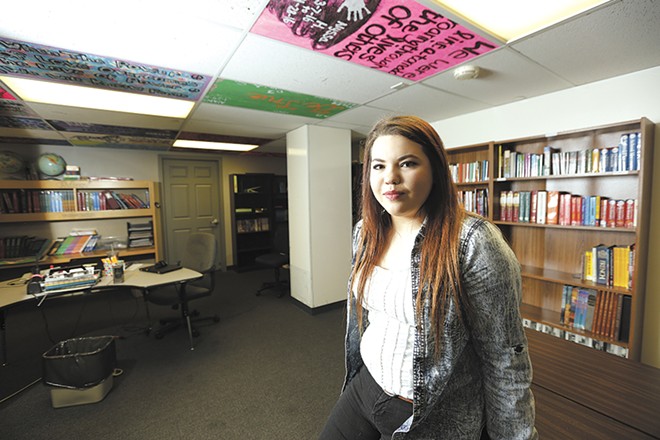
'I'M DONE WITH THIS KID'
In Spokane County alone, more than a hundred kids leaving juvenile detention are left homeless each year because they don't have a stable family to pick them up, and Department of Social and Health Services won't intervene unless their case meets the DSHS definition of abuse, neglect or abandonment.
Juvenile detention staff is required to make every attempt to release a kid to a responsible adult or to DSHS. But meeting the DSHS standard can be difficult, says Spokane County public defender Dave Carter. Even when a parent comes to court and says "I'm done with this kid," Carter says DSHS will sometimes still refuse to file a dependency petition, leaving the kid on their own.
Kids can file a Child in Need of Services petition, with the court requesting that they be placed in a home away from their parents. But Carter says that requires parental involvement in order to be granted. Carter says he has a client, a teenage boy, who filed a CHINS petition but could not get it implemented because nobody can find his mom, who has meth and alcohol abuse issues and several referrals to Child Protective Services in her background. Now that boy is couch surfing or on the street.
Carter says that even if the CHINS petition is granted, DSHS doesn't offer much assistance in helping kids find a place to live.
"It's those types of things where we're really frustrated," he says.
Carter says that sometimes, especially in winter, teens prefer staying in juvenile detention rather than on the street, or with an abusive parent, or in a teen shelter like Crosswalk in downtown Spokane. They'll sell weed in front of a cop in Riverfront Park, just so they're brought to detention, he says.
Washington First Lady Trudi Inslee, who has pushed to highlight the homeless youth population, says we need to stop thinking reunification with the family is something that can always happen.
"We do want reunification when it's a good result," Inslee says. "But that's not always gonna happen because of drug or chemical abuse, or physical abuse. The people not able to be reunified need to have other options."
AGING OUT
It's lunchtime on a summer day at Crosswalk teen shelter, and a dozen teens are eating at circular tables as if it's a school cafeteria. At night, the beds will come out.
For years, this shelter, which is supposed to be temporary, was Christian Bartlett's home. But when he turned 18, he couldn't stay here anymore. Now he sleeps on the street most days, the days he isn't able to stay at his girlfriend's house.
Bartlett was born in Bellingham. When he was 6, his dad took him from his mom and brought him to Florida. He ran away, calling the situation down there "abusive," and got a bus ticket from Florida to Montana, where his mom lived.
One day, he says, they drove a van to Spokane to visit his 16-year-old brother. They went to Walmart for food. Christian went to use the bathroom, and when he came out, the van, and his mother, were gone. He hasn't heard from her since.
He stayed with his brother for a few months, then on the street for a year, then at Crosswalk. He tried moving back to Florida, but says his dad wouldn't have him until he was 18. He works toward his GED whenever he can find bus fare to Spokane Falls Community College, and he says that this October he's going to move to Yellowstone National Park, where his dad will hook him up with a job as a line cook.
"Society expects you to counter everything that life throws your way," he says. "And it doesn't work like that."
Crosswalk is the only teen shelter for kids in Spokane. There's no shelter specifically for young adults in the entire region, so the only options for kids staying at Crosswalk who age out are either the streets or an adult homeless shelter. Bridget Cannon, the director of youth services for Volunteers of America, which runs Crosswalk, says kids like Christian often prefer the streets.
"If you're waking up at Crosswalk as a 17-year-old, you see your peers," Cannon says. "If you're an 18-year-old and you wake up in House of Charity [an adult homeless shelter], you see people who have been on the streets for 40 years. That's scary to think of them as your peers now."
'LESSER OF TWO EVILS'
Every region in Washington identified a bed shortage as the primary barrier to serving homeless youth, in the 42-page report compiled by A Way Home Washington with the help of the state's Office of Homeless Youth Prevention & Protection. Outside of Spokane, no surrounding county has a teen shelter.
In North Idaho, there is no shelter specifically for homeless teens, says James Curb, liaison for the federal McKinney-Vento Act in the Coeur d'Alene School District.
It wasn't until recently that any transitional housing was available for 18-to-24-year-olds in Spokane.
That's where Tristan Keck lives now, in transitional housing apartments at Maplehurst, an apartment building in downtown Spokane. Tristan, 17, is emancipated from his parents, meaning he's a legal adult. He says his parents did not accept that he was gay, and he ran away shortly after they found out. State numbers suggest that nearly a quarter of homeless youth identify as LGBTQ.
A couple of years ago, Tristan was sleeping outside, under bridges or against archways. He used drugs in an attempt to fight depression, then got clean and came to Crosswalk. Now, he goes to beauty school during weekdays and comes home to his own apartment. Someday, he wants to manufacture and distribute his own brand of cosmetic products.
The kids on the street or at Crosswalk hear the people who say it was a choice, who say the homeless kids can go home if they want, who say they're all troublemakers hurting businesses. Tristan agrees that there are homeless kids who could go home if they wanted, and some want to cause trouble. But for many, like him, what seems like a choice is really no choice at all.
"For me, it was making a choice of the lesser of two evils," he says. "It was a choice, but it was a choice to escape a bad situation for a better situation."
SCHOOL CONNECTIONS
CG, a 16-year-old boy identified here only by his initials, made it to class at North Central High School every day after sleeping in a field earlier this year. That was over the course of two weeks, after the house his parents rented was foreclosed on.
His family, including his younger siblings, got a room in a motel, but there was no room for him. He slept on his clothes and went to school for his meals. His backpack held his clothes, shoes and his book of poetry. There was no room for homework.
He'll live at Crosswalk indefinitely as he starts at a new high school, Lewis and Clark, this month. He has no plan for more stable housing and has fallen out of contact with his family; he says that they spend most of their money feeding their drug addictions. He's excited to attend school so he can play football.
Schools count homeless kids differently than the U.S. Department of Housing and Urban Development does. Schools, under 1987's McKinney-Vento Homeless Assistance Act, include students who may have a roof over their head, but who are staying with someone else; at a friend's house, for example. Under that definition, there are more than 30,000 homeless kids in Washington. Spokane's rate of homelessness is 33 percent higher than the state average, with more than 3,000 homeless students in Spokane County. Three-quarters of those students are doubling up with family or friends due to financial issues.
In Coeur d'Alene, more than 400 students fit this definition of homelessness, according to the school district.
Defining a homeless kid is one of the main barriers to helping them, says Sarah Miller, liaison for the federal McKinney-Vento Act in Spokane Public Schools.
"We don't even communicate in the same language for what's homeless and what's not, and so that's a huge barrier in understanding what we're talking about, and figuring out what we need to do to decrease those numbers," Miller says.
This is crucial, she says, because kids or families who are on the verge of living on the street, but are not quite there yet, can't access the same services as people who actually live on the street. She says that the best way to help homeless kids is to prevent it from happening in the first place.
For example, families may be in an unstable living situation, unable to find a new place to live because of a late payment on their record. That family may not qualify for rental assistance, or for a shelter, until they become homeless for a short period, Miller says.
The school district liaisons try to help kids in these situations access services. They also make sure that kids don't change schools, even as they move across town. That means coordinating bus routes to travel across school districts to get the kid to school. Sometimes districts even pay for a cab.
"We could go as far as Liberty Lake with students," says Mead School District McKinney-Vento liaison Kelly Schultz.
Randy Dorn, state superintendent of public instruction, says there's room for improvement in how schools help homeless kids stay in school. The idea of the school being the one constant for a kid whose life is dominated by change is good, but practically, it "doesn't work so well," he says. He adds that outside of urban areas, coordinating services becomes more difficult.
"I don't think we've done well at it," Dorn says. "I think we're trying to do better at it, but I think youth homelessness is really something people — up until a couple years ago — tried to hide."
UNDERLYING FACTORS
When Ryan Oelrich started working with homeless families, he thought he knew why they were homeless. He figured they made mistakes, or that they weren't hard workers.
What surprised him was that so many worked multiple jobs and were still unable to find stable housing in Spokane. Or how many ran into an unfortunate medical situation that drained them of all their money.
Oelrich's goal, as executive director of Priority Spokane, is to stabilize the lives of homeless families before they end up homeless, or "start swimming farther upstream." The organization is focusing on students in kindergarten through eighth grade in order to prevent them from becoming homeless teenagers, and encountering the trauma that goes along with it.
"It is incredibly traumatic to be homeless," Oelrich says. "Kids will spend the rest of their lives getting over that time when they had no idea where they were going to eat, or where they were going to sleep."
Priority Spokane is launching a pilot project this school year to help stabilize about 100 families in three Spokane County elementary schools: Logan, Deer Park and Arcadia. The organization will help house homeless families whose students attend these schools, and it will place community health workers in schools to identify who needs help. He says the end goal is not to give these families a handout, but to pay to get them housing and help them with education and employment. If families are stabilized for a few years, he says, "we can step back" and let them take care of themselves.
Andi Smith, a human resources senior policy advisor for Washington Gov. Jay Inslee, says that a first step in getting ahead of the problem was placing the Office of Youth Homelessness Prevention & Protection under the Department of Commerce, instead of DSHS.
"The Children's Administration [which is part of DSHS] really is the agency of last resort. They wait until harm has occurred. So if we want to get ahead, taking it out of the reactionary agency and into strategic planning is part of the rationale," Smith says.
Kim Justice, executive director of the Office of Homeless Youth Prevention & Protection, is on board with addressing root causes of homelessness, which often come down to general family dysfunction — neglect, domestic violence, drug abuse, sexual identity, economic instability. The office will complete a report by Dec. 1 meant to serve as a road map for combating the issue of youth homelessness, but Justice admits that the office is limited in how it can address those root causes.
"We can't eradicate all of those underlying factors," she says. "The strategies are aimed at providing interventions, knowing risk factors, catching families before they get to the part where everything falls apart and young people are running away from home."
Beyond the millions included in the 2016 budget through the Office of Homeless Youth, how much the state is willing to invest, and how effectively it will address these fundamental issues, are both questions nobody seems to know the answers to yet.
Oelrich says you can throw all the resources you want at kids and it won't help until somebody is willing to build a relationship with them. He says he will give presentations where people will come up to him and say the street kids are just lazy or rebellious. He always asks those people: Have you actually heard their stories?
"I have yet to meet a homeless teen where I can say, yes, they had a healthy home, great parents, no addiction problems, no mental health issues, and they say, 'Screw it, I'm gonna go be homeless — that sounds like fun to me,'" Oelrich says. "I've met the young person who was abused daily and beat up by their stepdad. I've met the young person who has serious mental health issues that are not being addressed, or addiction problems not being addressed.
"I've met those young people."
FEEDING CHANGE
Angelina is now living with her dad again, following her release from treatment. She thinks he can help her with her recovery.
Khanh Huynh is in jail now, charged with felony domestic violence harassment. His bail was increased to $100,000 after prosecutors argued that Angelina needed more protection. She sometimes calls him her ex, before correcting herself: "I got so used to calling him my boyfriend."
She wants a life at home, away from the streets, where people care about her. When she escaped and went to her friend's house, Angelina's dad brought her shampoo and conditioner. She says he wanted to help her even though she wasn't clean, even though she wasn't allowed back home then. Her little brother could fit his entire hand around her upper arm because she was so skinny.
She wants to be a chef someday, "because I like creating things for people, and I like seeing people eat the food I make. It's like giving people life, kind of, because you have to eat to live."
Angelina remembers when the heroin made her not want to eat, and she felt like she was dying. She was too weak to walk around. She just sat in the tent that had become her home and prison. She trusted nobody else out there. Nobody, she says, could get her out of that situation.
"It was something I had to do on my own." ♦





